Politics
Exclusive: The Shot from the Front that Hit JFK’s Right Temporal Bone by His Ear, Creating a Massive Blow-out Wound in the Occipital Bone at the Right Back of JFK’s Head-Excerpt From the Latest Book by Jerome Corsi and David Mantik

Excerpt from the New Book: David W. Mantik, M.D., Ph.D. and Jerome R. Corsi, Ph.D., The Assassination of John F. Kennedy: The Final Analysis (2024)
Read part one and two.
Dr. Michael Chesser: X-ray Film Evidence of an Oblique Shot
In JFK’s lateral X-ray film, Dr. Michael Chesser spotted a keyhole fracture in the temporal bone, near JFK’s right ear. Such a fracture was described in “Keyhole Fracture of the Skull,” in the December 2008 issue of the Military Medicine Radiology Corner:
A keyhole fracture has a characteristic pattern…of both gunshot entrance and exit trauma. Keyhole fractures can be created by bullets penetrating the skull at an angle, by a bullet yawing off path, or by grazing the skull at a tangential trajectory without penetrating into the intracranium. These fractures exhibit a circular entrance defect and a triangular exit deficit created by bone or bullet fragments propagating from the initial point of impact on external examination or CT imaging.[1]
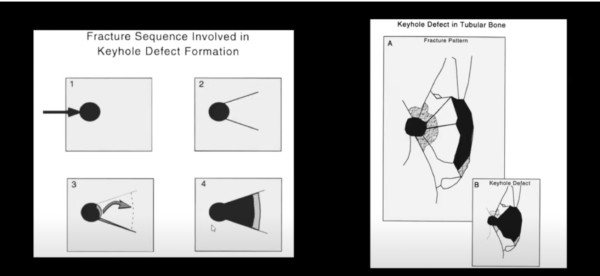
Figure 4.1
Keyhole Fracture Resulting from an Oblique Shot.
The source for Figure 4.1 is H.E. Berryman and W.M. Gunther, “Keyhole defect production in tubular bone,” Journal of Forensic Sciences 45, no. 2 (March 1, 2000): 483-487, https://europepmc.org/article/med/10782979. Figures 4.1–4.4 are from Michael Chesser’s presentation: “Reviewing the Autopsy X-Rays,” op. cit.
Chesser also cited a second peer-reviewed article (from the same journal in 1984):
Keyhole lesions of the skull at the site of a gunshot entrance wound have been previously described: common to the lesions are a circular or ovoid component with internal beveling and a triangular portion with external beveling. The circular portion is, in fact, the point of initial impact or entrance, and the triangular portion is the exit. The lesion usually indicates a tangential shot, often with a portion of projectile being shaved off and exiting.[2]
Chesser identified a triangular wound in JFK’s right temporal bone, near the right ear, as seen in these slides from his 2021 presentation to the Future of Freedom Foundation (Figures 4.2 and 4.3).
The keyhole is indeed a crucial discovery—because the trail of metallic particles across the top of the X-ray films cannot explain the keyhole trauma that lies well inferior to this trail. In other words, the keyhole requires a quite different trajectory (from the trail) and that clearly implies a quite different bullet—and therefore conspiracy. Most likely, it was caused by the bullet that entered near the right ear. After causing the keyhole trauma, the bullet then triggered the large occipital hole associated with the expulsion of the Harper Fragment. To close the case, Chesser confirmed that the premortem X-ray film does not show this keyhole trauma. For the goals of prior investigations then, the appointed radiologists were wise to ignore it. We can only imagine the groans of government lawyers if such a keyhole had been cited by these official radiologists.
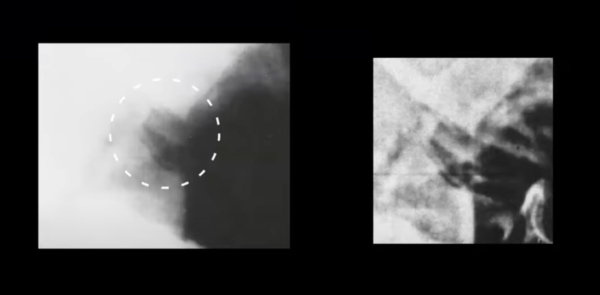
Figure 4.2
Keyhole Bullet Entry Wound.
Temporal Bone: JFK Lateral X-ray Film.
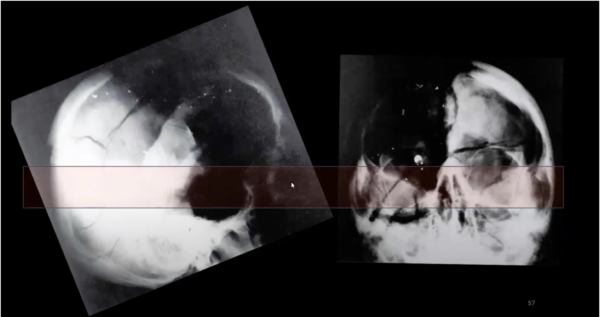
Figure 4.3
Temporal Bone: Bullet Entry Produces Keyhole Trauma.
JFK Autopsy X-Ray Films.
In the AP X-ray film, just compare the right temporal region to the left temporal region (Figure 4.4). We see many fractured bones as well as bone fragments in the right temporal region; these are absent on the left.
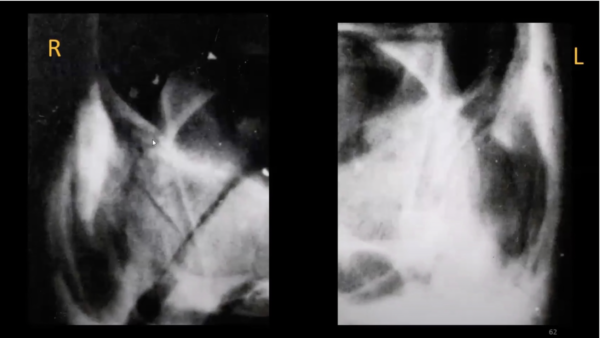
Figure 4.4
Right (R) Temporal Bone and Left (L) Temporal Bone,
from JFK’s AP Skull X-ray Film.
Dr. Don Curtis, DDS, was a first-year resident at Parkland Hospital in November 1963. Curtis told Chesser about his conversation with his supervisor, Dr. Robert Walker, DDS, a Parkland oral surgeon. Walker was in Trauma Room One. Curtis told Chesser:
I [Curtis] was standing at the other side of the gurney on the left side and Dr. [Kemp] Clark, on the right side, raised [JFK’s] head to describe the wound. I did hear him [Dr. Clark] say cerebellum, which places the wound posterior and inferior. After they [the other physicians] left, I went around to the head of the table, and what I saw, with the head back down on the pillow, was the right wound margin and cranial contents on the pillow. I did not see the right temporal wound, however, my chief, Dr. Robert Walker, told me the following morning that he did see what appeared to be a bullet hole in the right temple. He well knew a bullet hole.[3]
In 1985, Joseph McBride found a critical FBI memo buried among 98,755 pages of FBI documents released to the public during 1977–1978. Alan Belmont, the assistant director of the FBI, wrote the memo at the FBI’s Washington headquarters after 8:00 p.m. EST on November 22, 1963. Belmont was responsible for directing the FBI investigation of the assassination. He addressed the memo to FBI Associate Director Clyde Tolson, J. Edgar Hoover’s personal assistant, with copies to other top FBI bureaucrats.[4]
The memo reported Belmont’s telephone conversation with Dallas Special Agent in Charge (SAC) J. Gordon Shanklin, which occurred at 9:18 p.m. EST, i.e., during the autopsy. Here is the first paragraph:
I talked to SAC Shanklin in Dallas. He said arrangements have been made with Carswell Air Force Base to fly one of our Agents up to Washington with the rifle that was recovered by the police together with the fragments of bullet taken from Governor Connally and the cartridge cases. I told SAC Shanklin that Secret Service had one of the bullets that struck President Kennedy and the other is lodged behind the President’s ear and we are arranging to get both of these. [5]
McBride immediately recognized the significance of this memo. In his detailed 2013 book, Into the Nightmare, he commented that the Belmont memo “indicates that a bullet was secretly removed from President Kennedy’s head and never placed into evidence.”[6]According to Belmont, the bullet was “lodged behind the president’s ear,” a fact never disclosed by the Warren Commission or the HSCA.”[7] McBride stressed the importance of this document:
This crucial document invalidates the official version of the assassination that only three bullets were fired, all from behind, and that none was recovered during the autopsy at Bethesda Naval Hospital in Maryland. Other evidence about the fatal crossfire, including a gunshot wound to the president’s right temple, as well as the abundant evidence the president’s body was secretly altered to disguise his wounds and their sources, supports the information in this memo.[8]
Eyewitnesses: A Grassy Knoll Shot Caused the Temple Wound
In volume 2 of Inside the ARRB, Douglas Horne listed witnesses who saw JFK’s head struck from the right front. This shot blew out the right rear of JFK’s head and sent tissue debris to the left rear.
The family of Phillip Willis, including his wife Marilyn and daughters Rosemary and Linda, were on the south side of Elm Street (left of the limousine). Willis took one of the famous color photographs as the limousine approached the Stemmons Freeway sign: “As I was about to squeeze my shutter, that is when the first shot rang out and my reflex just took that picture at that moment.”[9]
In his 1967 book Six Seconds in Dallas, Josiah Thompson reported his interview with Marilyn Sitzman, the receptionist for Abraham Zapruder’s clothing company. She stood with Zapruder on the concrete pedestal of the John Neely Bryan pergola on Elm Street while he filmed. Zapruder and Sitzman were within seventy-five feet of the limousine when the bullet shattered JFK’s head.
Miss Sitzman: And the next thing that I remembered clearly was the shot that hit directly in front of us, or almost directly in front of us, that hit him on the side of his face.
Thompson: Where on the side of the head did that shot appear to hit?
Miss Sitzman: I would say it’d be above the ear and to the front.
Thompson: In other words, if one drew a line vertically upward from the tip of the ear, it would be forward of that line?
Miss Sitzman: Yes.
Thompson: It would then be back of the temple, but on the side of the head?
Miss Sitzman: Between the eye and the ear. And we could see his brains come out, you know, his head opening; it must have been a terrible shot because it exploded his head.[10]
Nigel Turner, in his five-part 1988 television documentary, The Men Who Killed Kennedy, aired an interview with Marilyn Willis. In episode one, she recalled:
The head shot seemed to come from the right front. It seemed to strike him here [gesturing to her upper right forehead, up high at the hairline], and his head went back, and all of the brain matter went out the back of the head. It was like a red halo, a red circle, with bright matter in the middle of it—it just went like that.[11]
In episode five, she was asked to recall her most indelible memory. She responded: “[It was] the head shot; seeing his head blow up. I can see it just as pain [today as I could then] … it’s red, it’s very brilliant, it’s cone-shaped, going back—that’s my impression.”[12]
Thompson also interviewed William Newman (Figure 1.3), who stood on the north curb of Elm Street (right of the limousine), about fifteen feet from JFK, with his wife Gayle Newman and their two small sons:
Thompson: Now could you tell me about the impact on the President’s head, what you saw? There’s a diagram you drew for me where you put it right at the ear.
William Newman: That’s what I saw. The way he was hit, it looked like he had just been hit with a baseball pitch; just like a block of wood fell over his ….
Thompson: You just bobbed your head backwards and over towards the left. The location that you drew is right about the ear.
William Newman: In my opinion the ear went.[13]
Newman was confident that the shot that detonated JFK’s head came from the Grassy Knoll behind him.
Thompson: Now could I ask you a little more about this, try to get your immediate response? I take it, it was your immediate response—in your affidavit of the 22nd—that the shots were somehow right back of you?
William Newman: That’s right. Well, of course the President’s being shot in the side of the head, by the third shot—I thought the shot was fired from directly above and behind where we were standing. And that’s what scared us, because I thought we were right in the direct path of gunfire.[14]
Newman never thought the gunfire came from the TSBD.
Thompson: But it’s your feeling that the shots were coming from over your…right behind you, based on (1) the sound of the shots, (2) the impact on the President’s head, and (3) the movement of the President’s head after impact. Would that be a fair statement?
William Newman: Right. Well, I think everybody thought the shots were from where I’m saying—behind us—because everybody went in that direction. Must have.
Thompson: Everyone did run in that direction; I’ve seen the films. This is probably pushing your own recollections too far, but I’ll try it anyway. When you say in back of you, do you have any feeling…say, if I stand here, and I say “in back of me,” do you have any feeling if it was back of me in this direction or back of me in this direction? Did it appear to be back of you towards the Texas School Book Depository or towards the general area of the stockade fence and railroad? Do you have any recollection at all?
William Newman: Well, this is going to sound peculiar, but I was thinking more just the opposite of the building…actually the thought never entered my mind that the shots were coming from the building.[15]
In his 1966 book Rush to Judgment, Mark Lane interviewed Charles Brehm, who stood with his son near the south curb of Elm Street (left of the limousine). Brehm was within about twenty feet when the bullet “shattered the President’s head.”[16] He saw a piece of JFK’s skull explode out of the head. “That which appeared to be a portion of the President’s skull went flying slightly to the rear of the President’s car and directly to its left,” Brehm said. “It flew over toward the curb to the left and to the rear.”[17]
Lane pointed out that Deputy Constable Seymour Weitzman found skull fragments on the south side of Elm Street (left of the limousine), approximately “8 to 12 inches from the curb.” Lane emphasized that this location “was consistent with the bullet having been fired from the north, where the grassy knoll is located, since bone matter tends to follow the trajectory of the bullet.”[18]
“The Dallas Motorcycle Policemen to the Left Rear of the Limousine Were Covered by Bloody Debris” [19]
When a headshot struck Kennedy, Dallas police officer B. J. Martin was on the left outside motorcycle, about five feet to the left and six to eight feet to the rear.[20] Martin testified that he and his motorcycle were splattered with skull and brain debris. “I noticed that there were blood stains on the windshield on my motor[cycle], and then I pulled off my helmet and I noticed there were blood stains on the left side of my helmet.”[21] He also noticed “other matter that looked like pieces of flesh.”[22]
Martin’s partner that day was police officer Bobby W. Hargis, who rode the inside rear motorcycle. Hargis testified to the WC that he was hit by debris from the fatal shot:
Yes; when President Kennedy straightened back up in the car [after the first shot] the bullet hit him in the head, the one that killed him and it seemed like his head exploded, and I was splattered with blood and brain, and kind of a bloody water.[23]
The debris hit Hargis with such force that he told reporters the next day, “I thought at first I must have been hit.”[24]
Horne commented:
Hargis was so certain, based upon the impact debris, that the shot that caused it [JFK’s head wound] had come from the right front that he parked his motorcycle at the curb on the south side of Elm and went running across the street to see if he could spot anyone in the grassy knoll area.[25]
In his testimony to the WC, Hargis made clear that his impression was that shots were coming from the grassy knoll. Hargis explained:
Well, at the time it sounded like the shots were right next to me. There wasn’t any way in the world I could tell where they were coming from, but at the time there was something in my head that said they probably could have been coming from the railroad overpass, because I thought since I had got splattered, with blood—I was just a little back and left of—just a little bit back and left of Mrs. Kennedy, but I don’t know.”[26]
Hargis testified that after being splattered with Kennedy’s brain matter, he parked his motorcycle on the left side of the motorcade, i.e., the south side of Elm Street. He ran across Elm Street toward the railroad pass, running up the incline on the grassy knoll to see if he could find the shooter. In Richard Trask’s 1994 book Pictures of the Pain, Wilma Bond’s photograph shows Hargis returning to his motorcycle.[27]
In Six Seconds in Dallas, Thompson discusses police officer James Chaney, who rode the right inside motorcycle and police officer Marrion Baker, who rode the right outside motorcycle. After the shooting, Baker parked his motorcycle on the north curb in front of the TSBD and ran into the building. Baker told the WC that Chaney had said this: “…two shots hit Kennedy first and then the other one hit the Governor [Connally].”[28]Thompson wanted to know if Chaney had been struck by debris, but the police department blocked Thompson’s efforts to locate Chaney. Thompson commented: “If it turns out that Chaney was not splattered with impact debris, then the [WC] had a double reason for not calling him to testify.”[29]
In his WC testimony, Baker clarified that the police officers on the left (Martin and Hargis) were hit by impact debris, but he did not cite himself or Chaney (on the right) as hit. Baker described a conversation among the Dallas motorcycle men:
Well, we were just discussing, each one of us had a theory, you know where, how it happened, and really none of us knew how it happened. It just happened, and where they was at in place, you know, in reference to the car, would be about the only thing they could say, and at the time, the first shot they didn’t know where the shot came from. The second shot they still didn’t know, and then the third shot some of them over to the left hand side [of the limousine], the blood, and everything hit their helmets and their windshields and then they knew it had to come from behind.[30]
WC assistant counsel David Belin pressed Baker regarding officer B. J. Martin:
Mr. Belin: What did he [officer B. J. Martin] say to you about blood or something?
Mr. Baker: Like I say, we were talking about where the shot came from, and he said the first shot he couldn’t figure it out where it came from. He [Officer B. J. Martin] turned his head backward, reflex, you know, and then he turned back and the second shot came off, and then the third shot is when the blood and everything hit his helmet and his windshield.
Mr. Belin: Did it hit the inside or the outside of his windshield, did he say?
Mr. Baker: It hit all this inside. Now, as far as the inside or outside of the windshield. I don’t know about that. But it was all on the right-hand side of his helmet.
Mr. Belin: Of his helmet?
Mr. Baker: On his uniform also.
Mr. Belin: On his uniform[?]
Mr. Baker: That is right.
Mr. Belin: And he was riding to the left of the President and you say ahead of the President?
Mr. Baker: On the left-hand side.
Mr. Belin: But a little ahead of him?
Mr. Baker: Yes, sir. They were immediately in front of the car.[31]
Multiple photographs clearly show four motorcycle escorts beside the limousine; each one was to the rear of the limousine during the fusillade. The Dallas police soon agreed that the lone assassin was Oswald, so every police officer was forced to toe the line: no frontal shots were allowed.
Baker’s statement clearly implies that Martin and Hargis (on the left rear) had been hit by debris, despite Baker’s obvious attempts to claim that the motorcycle escort had been in front of the limousine. Clearly, Belin wanted Baker to testify that blood and brain matter would have hit the inside of the windshield, so as to position the fatal shot from the rear. This explains Baker’s contorted answer: “It hit all this inside. Now, as far as the inside or outside of the windshield. I don’t know about that. But it was all on the right-hand side of his helmet.”[32]
Two Frontal Headshots
Douglas Horne (Inside the ARRB) was the first to propose two separate frontal headshots. Before that, no one had seriously considered this option, so Horne had thereby decisively advanced the case. Before Horne, everyone saw an X-ray fragment trail that disintegrated before exiting and a large hole at the right rear of the head (without any associated bullet fragments). These two items did not truly correlate, but no one seriously objected until Horne had his epiphany. Now, over ten years later, the evidence for two separate frontal head shots is formidable. One bullet entered in front of the right ear and exited at the right rear, causing a large hole. The second frontal bullet entered the right forehead at the hairline, consistent with the fragment trail on the X-ray films, but it did not exit. Instead, it merely fragmented. Sadly, most researchers today still cannot distinguish between these two headshots. I have published supporting images in my hardcover book to discriminate between them. Some are shown here in Figure 4.5. For more, see Appendix G. To date, no one has even tried to refute these two different scenarios.
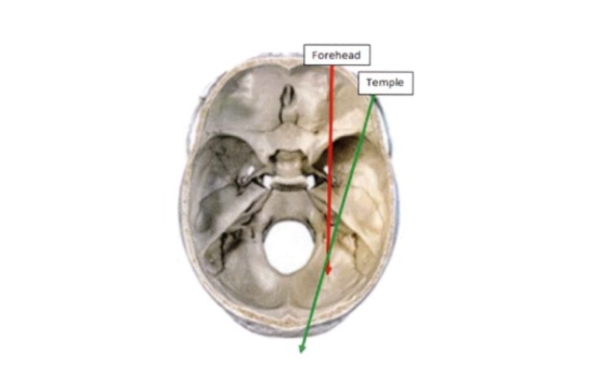
Figure 4.5
JFK: Two Frontal Headshots.
The Vertical Red Arrow Represents the Forehead Shot.
The Oblique Green Arrow Represents the Temple Shot.
The source for Figure 4.5 is David W. Mantik, The JFK Assassination Decoded, op. cit., p. 300.
Figure 4.5 clearly distinguishes the two frontal shots. The vertical (AP) arrow represents the forehead shot, while the oblique arrow represents the temple shot. The forehead bullet does not exit the skull; instead it disintegrated into the particle trail on the X-ray films. The temple bullet is not represented by particles anywhere in the X-ray films, but it is consistent with the large right occipital blowout.[33]
It is also consistent with many eyewitnesses (in Dealey Plaza, at Parkland Hospital, and at the Bethesda autopsy) who reported an entry site above and slightly in front of the right ear. The tissue debris from the temple bullet exited the skull, as suggested by the large occipital defect. It is also consistent with Dealey Plaza witnesses (especially those to the left of the limousine) who were struck by flying debris from the occipital blowout.
These two shots are also located at two quite different vertical levels (Figure G.2). It is time to stop conflating these two frontal shots, which is precisely what most researchers blindly do. (After all, these two assassins might prefer separate credit.)
Clint Hill and the Oblique Shot That Detonated JFK’s Head
SS Agent Clint Hill was assigned to Jacqueline Kennedy on November 22, 1963. He jumped from the follow-up car and ran to the rear handhold on the limousine after the first shots. Horne noted that Hill was “the closest reliable witness” to JFK’s head wounds.[34]
In November 30, 1963, Hill recalled:
As I lay over the top of the back seat I noticed a portion of the President’s head on the right rear side was missing and he was bleeding profusely. Part of his brain was gone. I saw a part of his skull with hair on it lying in the seat.[35]
Hill described the first lady’s reaction:
Mrs. Kennedy shouted, “They’ve shot his head off;” then turned and raised out of her seat as if she were reaching to her right rear toward the back of the car for something that had blown out.[36]
In his WC testimony, he also offered a graphic description of the scene at Parkland:
The right rear portion of his head was missing. It was lying in the rear seat of the car. His brain was exposed. There was blood and bits of brain all over the entire rear portion of the car. Mrs. Kennedy was completely covered with blood. There was so much blood you could not tell if there had been any other wound or not, except for the one large gaping wound in the right rear portion of the head.[37]
Hill testified that Jackie climbed onto the trunk to retrieve skull or brain tissue:
Mr. Specter: You say that it appeared that she [Jacqueline Kennedy] was reaching as if something was coming over to the rear portion of the car, back in the area where you were coming to?
Mr. Hill: Yes, sir.
Mr. Specter: Was there anything back there that you observed, that she might have been reaching for?
Mr. Hill: I thought I saw something come off the back, too, but I cannot say that there was. I do know that the next day we found the portion of the President’s head.
Mr. Specter: Where did you find that portion of the President’s head?
Mr. Hill: It was found in the street. It was turned in, I believe, by a medical student or somebody in Dallas.[38]
Most likely then, Hill saw the HF blown out of the back of JFK’s head.
At a book signing (available on YouTube.com), Hill described his run from the follow-up car to the limousine:
As I approached the vehicle [JFK’s limousine] there was a third shot. It hit the President in the head, upper right rear of the right ear, causing a gaping hole in his head, which caused brain matter, blood, and bone fragments to spew forth out over the car, over myself. At that point Mrs. Kennedy came up out of the back seat onto the trunk of the car. She was trying to retrieve something that had gone off to the right rear. She did not know I was there. At that point I grabbed Mrs. Kennedy, put her in the back seat. The President fell over into her lap, to his left.
He continued:
The right side of his head was exposed. I could see his eyes were fixed. There was a hole in the upper right rear portion of his head about the size of my palm. Most of the grey matter in that area had been removed, and was scattered throughout the entire car, including on Mrs. Kennedy. I turned and gave the follow-up car crew the thumbs-down, indicating that we were in a very dire situation. The driver accelerated; he got up to the lead car, which was driven by Chief Curry, the Dallas Chief of Police…. [39]
On the right side of JFK’s head is a massive bloody wound in Z-331 (Figure 4.11).

Figure 4.11
Z-331.
The right side of JFK’s head explodes.
Z-343 is where the FBI said that Hill first placed his hand on the limousine—thirty frames (nearly two seconds) after Z-313 (Figure 4.12).
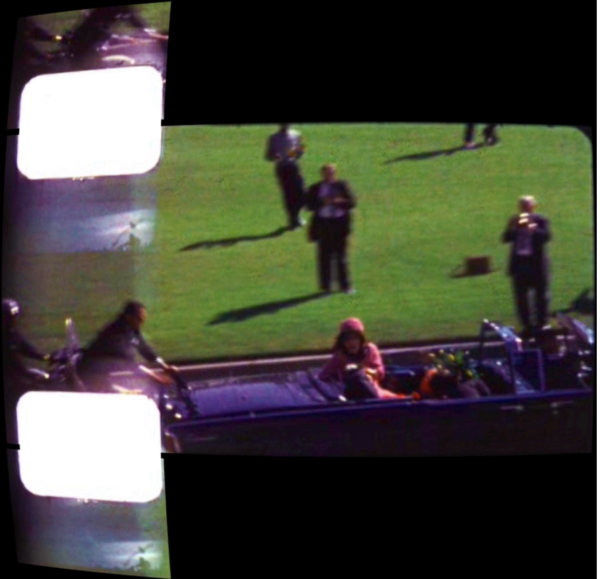
Figure 4.12
Z-343.
Hill reaches the limousine nearly two seconds after Z-313.
By Z-346, JFK has collapsed to his left, sinking into the back seat (Figure 4.13).
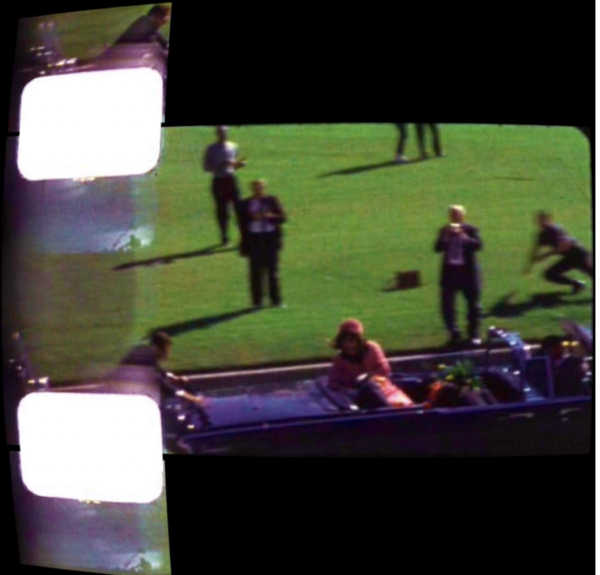
Figure 4.13
Z-346.
JFK collapses to his left, sinking into the back seat.
By Z-348, Jackie approaches the trunk (Figure 4.14).
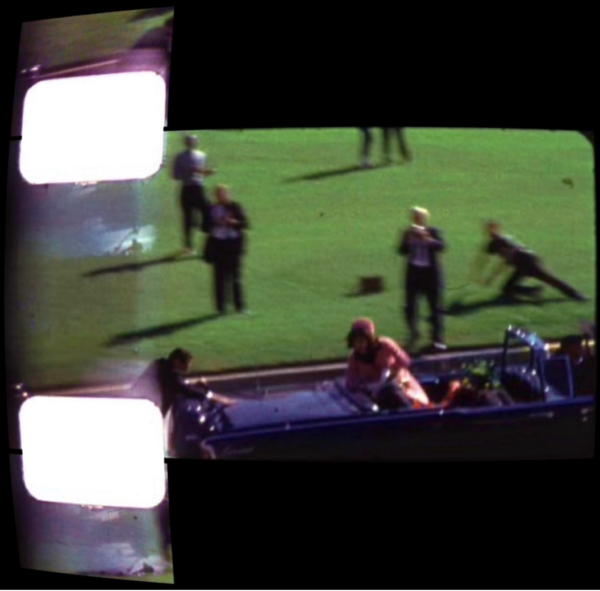
Figure 4.14
Z- 348.
Jackie climbs onto the trunk.
According to the FBI, Hill’s foot did not reach the bumper until Z-368; both feet reached at Z-381 (Figure 4.15).

Figure 4.15
Z-381.
Both of Hill’s feet reach the bumper.
By Z-388, Clint Hill appears to be assisting Jackie back into her seat (Figure 4.16).
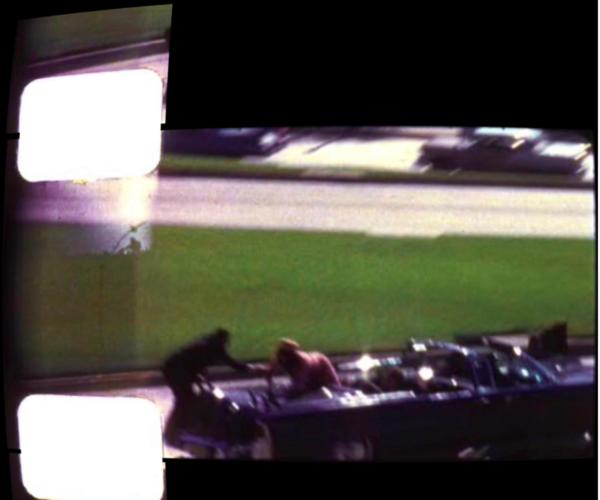
Figure 4.16
Z-388.
Clint Hill tries to assist Jackie.
In his 2012 book Mrs. Kennedy and Me, Hill offered a similar description. He described running toward the limousine (emphasis in the original):
I’m almost there. Mrs. Kennedy is leaning toward the president. I am almost there. I was almost there. And then I heard the shot. The third shot. The impact was like the sound of something hard hitting something hollow—like the sound of a melon shattering onto cement. In the same instant, blood, brain matter, and bone fragments exploded from the back of the president’s head. The president’s blood, parts of his skull, bits of his brain were splattered all over me—on my face, my clothes, in my hair.[40]
In his 2010 book, The Kennedy Detail, former SS agent Gerald Blaine confirmed Hill’s memory: “Clint Hill was just feet from his goal, his eyes focused on Mrs. Kennedy, when he heard the third shot and the gruesome thump of President Kennedy’s head exploding.”[41]
Hill leaves little doubt that the oblique headshot occurred well after Z-313. Most likely, this shot struck just before Hill’s hand reached the limousine. Drs. A. B. Cairns and Jack C. Harper were correct: HF was occipital bone.
Jackie’s Reaction
At the end of the Zapruder film, just before the Triple Overpass, a frantic Jackie is propping JFK up into a full sitting position, as if he were alive. JFK researcher Gerda Dunckel has produced a remarkable YouTube video using a rarely watched sequence in the Zapruder film, from Z-452 to Z-457.[42]
In her YouTube video, Dunckel identified the occupants of the limousine as the car approached the triple underpass (Figures 4.17).

Figure 4.17
Gerda Dunckel YouTube Video.
Z-458, Enhanced and Enlarged:
Limousine Occupants,
Just Before the Triple Overpass
A few frames later, Dunckel enhanced and enlarged Z-456 to show the gaping wound at the right rear of JFK’s head (Figure 4.18).

Figure 4.18
Gerda Dunckel YouTube Video.
Z-456, Enhanced and Enlarged:
Exit Wound at Right Rear of JFK’s Head,
Just Before the Triple Overpass
[1] CT = Computed Tomography. The reference is to Second Lt. Aaron M. Jackson, USA, et. al., “Keyhole Fracture of the Skull,” Military Medicine Radiology Corner, vol. 173 (December 2008): 1, https://apps.dtic.mil/sti/pdfs/ADA528579.pdf.
To illustrate a keyhole fracture, Chesser referenced the 2000 Journal of Forensic Sciences (Figure 4.1).
[2] D.S. Dixon, “Exit keyhole lesion and direction of fire in a gunshot wound of the skull,” Journal of Forensic Sciences 29, no. 1, (January 1, 1984): 336-339, https://europepmc.org/article/med/6699601.
[3] Email from Don Curtis to Mike Chesser, May 19, 2019.
[4] Joseph McBride, Into the Nightmare: My Search for the Killers of President John F. Kennedy and Officer J. D. Tippit (Berkeley, CA: Hightower Press, 2013), pp. 556-568, at p. 556.
[5] A. H. Belmont to Mr. Tolson, FBI memorandum, November 22, 1963, in Inside the ARRB, ed. Douglas Horne, Mary Ferrell Foundation, “Appendix 14: Two controversial FBI documents from November 22, 1963, pertaining to bullets,” https://www.maryferrell.org/showDoc.html?docId=145280#relPageId=75.
[6] Joseph McBride, Into the Nightmare, op. cit., p. 556.
[7] Ibid. A subsequent chapter will introduce multiple, mostly intact, bullets into this case, so it is problematic for normal human beings to identify an authentic Magic Bullet. On the contrary, Specter found this to be trivial—he simply ignored all the other bullets. Life is painless when evidence can be disregarded without penalty.
[8] Ibid.
[9] Richard B. Trask, Pictures of the Pain: Photography and the Assassination of President Kennedy (Danvers, MA: Yeoman Press, 1994), pp. 167-182, at p. 171. Trask commented: “Later government research placed this photograph as being taken at about the same time as Zapruder frame #Z202.”
[10] Josiah Thompson, Six Seconds in Dallas, op. cit., p. 102. Thompson taped this interview with Sitzman on November 19, 1966.
[11] Douglas Horne, Inside the ARRB, vol. 4, op. cit., pp. 1138-1139.
[12] Ibid., p. 1139.
[13] Josiah Thompson, Six Seconds in Dallas, op. cit., p. 103-104, at p. 103.
[14] Ibid.
[15] Ibid., p. 104. Emphasis in original.
[16] Mark Lane, Rush to Judgment: A Critique of the Warren Commission’s Inquiry into the Murders of President John F. Kennedy, Officer J. D. Tippit and Lee Harvey Oswald (New York: Holt, Rinehart & Winston, 1996), p. 56.
[17] Ibid., p. 56.
[18] Ibid.
[19] Douglas Horne, Inside the ARRB, op. cit., vol. 4, p. 1142.
[20] “Testimony of B. J. Martin,” Hearings before the President’s Commission on the Assassination of President Kennedy, vol. 4, op. cit., pp. 289-293, at p. 290.
[21] Ibid., p. 292.
[22] Ibid.
[23] “Testimony of Bobby W. Hargis,” Hearings before the President’s Commission on the Assassination of President Kennedy, vol. 6, op. cit., pp. 293-296. at p. 294.
[24] Douglas Horne, Inside the ARRB, op. cit., vol. 4, pp. 1142.
[25] Ibid.
[26] Testimony of Bobby W. Hargis,” op. cit., pp. 294-295.
[27] Richard B. Trask, Pictures of the Pain, op. cit., pp. 207-209, at p. 208.
[28] “Testimony of Marrion L. Baker,” Hearings before the President’s Commission on the Assassination of President Kennedy, vol. 3, op. cit., pp. 242-270, at p. 266.
[29] Josiah Thompson, Six Seconds in Dallas, op. cit., footnote 7, pp. 112-113.
[30] “Testimony of Marrion L. Baker,” op. cit., pp. 264-265.
[31] Ibid., p. 265.
[32] Ibid.
[33] However, this temple bullet may well have produced fragments that were visible on the original X-ray films. Several autopsy witnesses support this possibility. It is also striking that the pathologists reported precisely such a trail in their official autopsy report. Their mysterious lower trail is often overlooked, but perhaps it was originally authentic. It is obviously not there now.
[34] Douglas Horne, Inside the ARRB, op. cit., vol. 4, p. 1140.
[35] “Statement of Special Agent Clinton J. Hill, dated Nov. 30, 1963,” in Hearings before the President’s Commission on the Assassination of President Kennedy, CE 1024, op. cit., vol. 18, pp. 740-745, at p. 742.
[36] Ibid.
[37] “Testimony of Clinton J. Hill, Special Agent, Secret Service,” Hearings before the President’s Commission on the Assassination of President Kennedy, op. cit., vol. 2, pp. 132-144, at p. 141.
[38] Ibid., p. 140.
[39] James H. Fetzer, “Who’s telling the truth: Clint Hill or the Zapruder film?” The Education Forum, January 12, 2011, https://educationforum.ipbhost.com/topic/17242-whos-telling-the-truth-clint-hill-or-the-zapruder-film/.
Also see: Warwick’s Books, “Warwick’s Books Presents The Kennedy Detail: JFK’s Secret Service Agents,” December 14, 2010, https://www.youtube.com/watch?v=lYpY8zI_wwA&t=1482s.
[40] Clint Hill with Lisa McCubbin, Mrs. Kennedy and Me (New York: Gallery Books, 2012), p. 290.
[41] Gerald Blaine and Lisa McCubbin, The Kennedy Detail: JFK’s Secret Service Agents Break Their Silence (New York: Gallery Books, 2010), p. 216.
[42] GerdaDunckel, “Dead JFK rising from his seat …(?)” January 9, 2012, https://www.youtube.com/watch?v=lDCJ3Ndvz9M.
Read the full article here


















